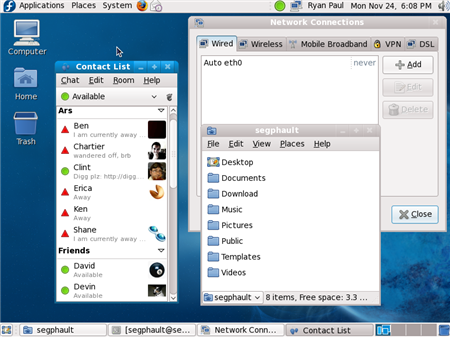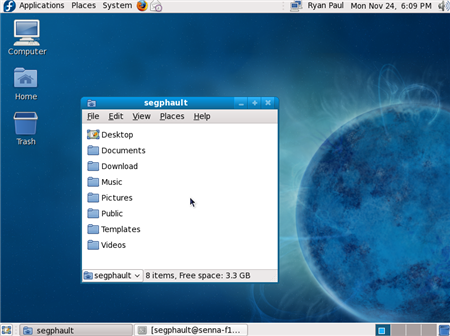It's time for me to wear my special hat again. The Fedora developer community has announced the official release of Fedora 10, a new version of the popular open source Linux distribution. This release is a promising step forward for Fedora and it introduces some important new features and technologies that bring more robustness and usability to the desktop user experience.
Fedora 10 is built on Linux kernel version 2.6.27, which was officially released in October. This version of the kernel comes with improved compatibility for popular webcam devices and also includes the new Atheros ath9k wireless driver. Firefox 3.0.4, the latest bugfix release of the popular open source web browser, is also included in the default installation.
KDE and GNOME in Fedora 10
Fedora 10 offers installation options for both GNOME 2.24 and KDE 4.1, the latest versions of the two most popular Linux desktop environments. GNOME 2.24, which was released in September, introduced the Empathy instant messaging client and also brought tabbed browsing and other improvements to GNOME's Nautilus file manager.
Empathy is built on the Telepathy instant messaging framework and is designed to supply audio/video chat functionality and significantly tighter desktop integration than the incumbent Pidgin messaging program. Although Empathy shows an enormous amount of promise and could prove to be a big step forward for GNOME messaging, it is still very rough around the edges and is missing some features. Some distributions—including Ubuntu—have declined to ship Empathy in recent releases. It was initially included in the Fedora 10 release candidate, but it was swapped back out for Pidgin in the final release at the very last minute. Users who want to try Empathy can install it from the repository, but Pidgin is still the default in this release. My own testing has confirmed that it is sufficiently robust for day-to-day use, but I think it really needs a bit more time to bake before it will be crispy enough to beat Pidgin in a taste test.
The Fedora developers are committed to ensuring that KDE is well-supported in the distribution, but they have faced some challenges because of the significant differences between the KDE and Fedora development cycles. KDE 4.0 was shipped with Fedora 9 and KDE 4.1 was pushed later along with some features that were backported from the trunk. It looks like we will see a similar move in Fedora 10—the OS ships with KDE 4.1 and will likely be updated when KDE 4.2 is released at the end of January.
KDE 4.1, which was released in July, finally delivered on the next-generation desktop promise of the KDE 4 series. KDE 4.2 will continue to advance the desktop environment and bring more robustness and usability.
Significant new features
One of the most significant new features in Fedora 10 is glitch-free PulseAudio (PA). The PA sound server—which was originally included in Fedora 8—brings a whole new set of modern capabilities to the Linux audio stack and has important features like support for controlling the volume of individual audio streams, moving audio streams between devices, and outputting audio streams simultaneously to multiple devices. It also has some really impressive advanced capabilities, like dynamic volume adjustment and network transparent stream redirection using Avahi for network autodiscovery.
PA represents an enormous advancement for the Linux audio experience, but the transition has been challenging. The new glitch-free version of PulseAudio smooths out some of the rough edges. It is a rewrite that implements timer-based audio scheduling. This will significantly reduce the potential for dropped audio and will facilitate better handling for latency. It could also potentially boost battery life by cutting down on the number of interrupts. This effort has been championed by Red Hat's Lennart Poettering and Fedora is the first distribution in which it will be included by default.
Fedora 10 also includes a new version of the Network Manager utility, which is used to configure Fedora's connectivity settings. The new version has built-in support for connection sharing. This is useful in a variety of contexts, particularly when a user with a 3G card wants to share it with other computers via an ad hoc WiFi network.
Fedora's RPM package management system got a major overhaul for this release. RPM 4.6 has many new features and a cleaner code base. Some legacy limitations have been eliminated and the maximum file size within packages has been increased to 4GB. For a complete list of RPM improvements, read the draft of changes that have been made since RPM 4.4.x at the RPM web site.
PackageKit, a generic package management frontend with a user-friendly graphical interface and support for programmatic manipulation through a D-Bus API, is more tightly integrated in Fedora 10. It is now integrated with GStreamer and can automatically install codecs when the user encounters media formats that are not natively supported. Fedora will still not include or provide access to patent-encumbered codecs, however, so users will have to configure third-party repositories in order for the feature to work.

Some startup improvements have been implemented in Fedora 10, too. Using readahead helped the Fedora developers reduce the startup time by roughly ten percent. This is also the first Fedora release to use Plymouth, a new graphical startup system that doesn't require an X server. The new graphical boot display doesn't work on all hardware, but there is a text-based fallback for instances in which it fails. The Fedora developers have published a video that shows Plymouth in action.
A little late, but worth the wait
The Fedora 10 release arrived a few weeks later than originally planned because the project's servers were infiltrated in August by malicious hackers. This security breach forced extensive audits and made the Fedora developers take some of the key infrastructure offline. The systems were brought back up after the group confirmed that Fedora source code had not been manipulated or compromised.
Despite the challenges faced during the development process, Fedora 10 is a strong release with lots of polish and an excellent assortment of new features. The user experience is great and the software performed well during my tests. Fedora 10 is available today from the project's web site. The HTTP mirrors typically get hammered, so we recommend using BitTorrent. For more details, see the official release notes.




reader comments